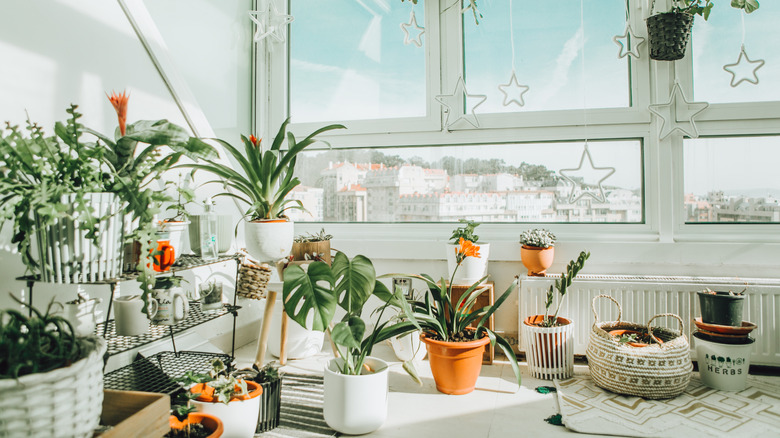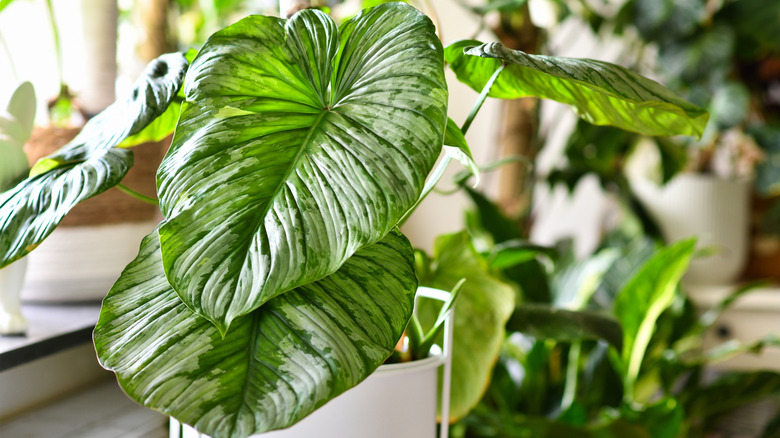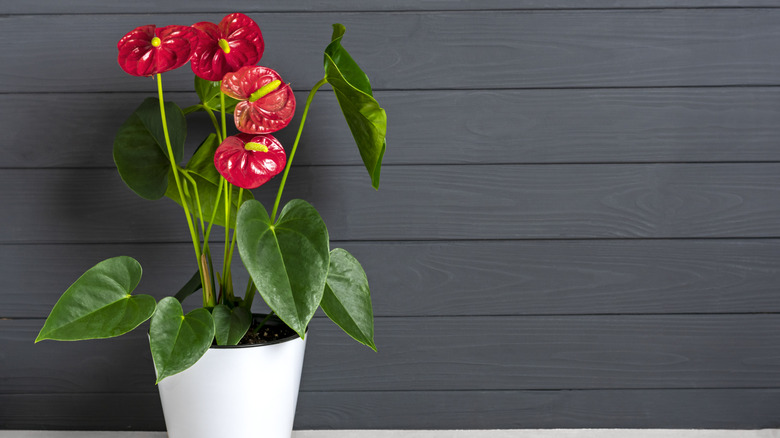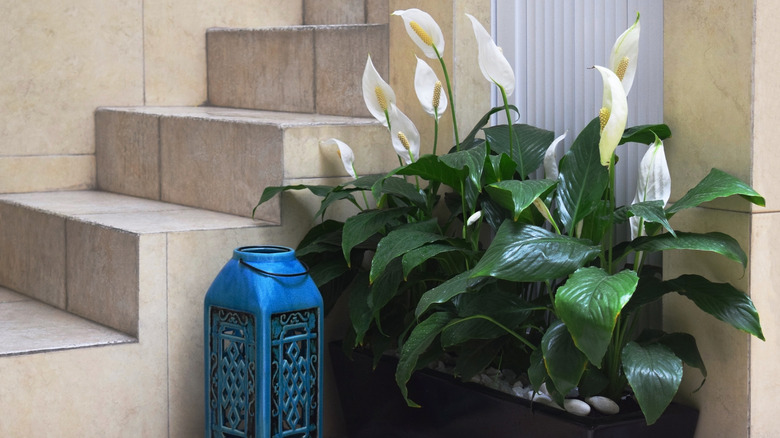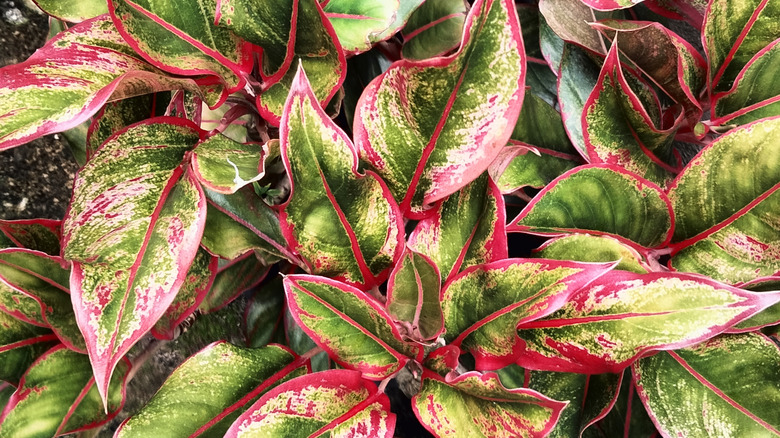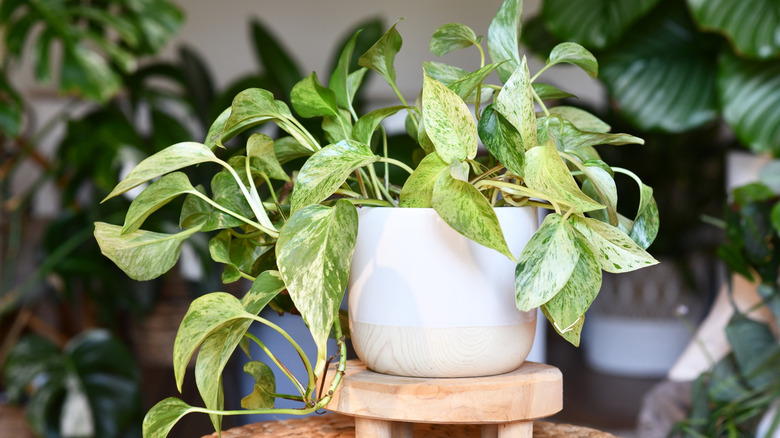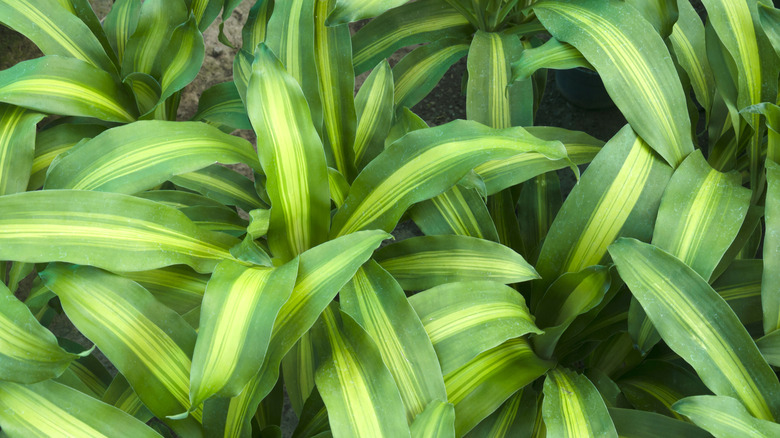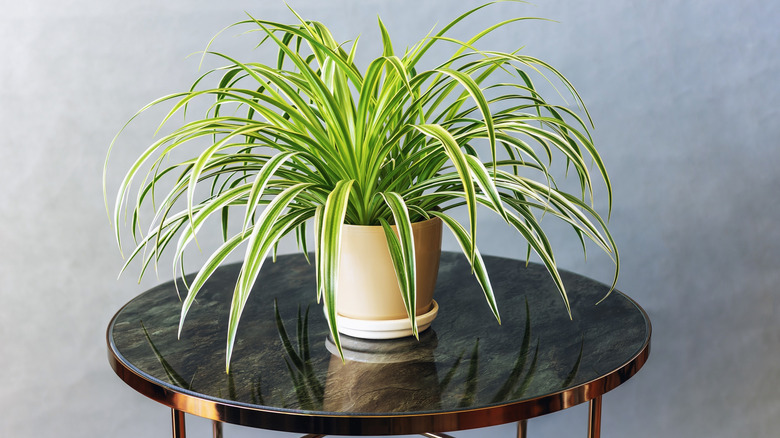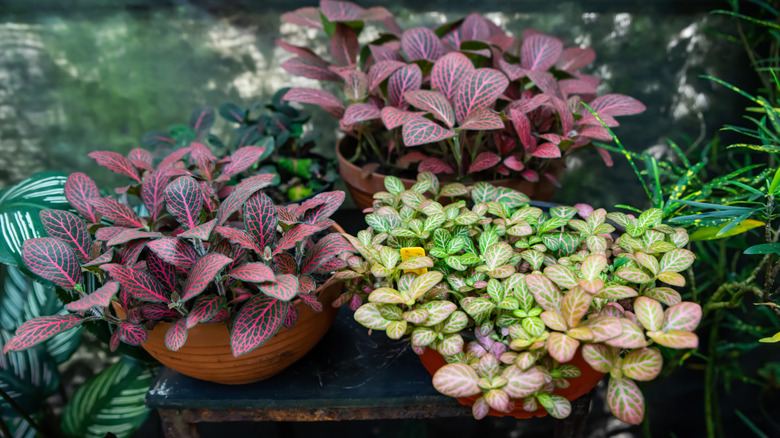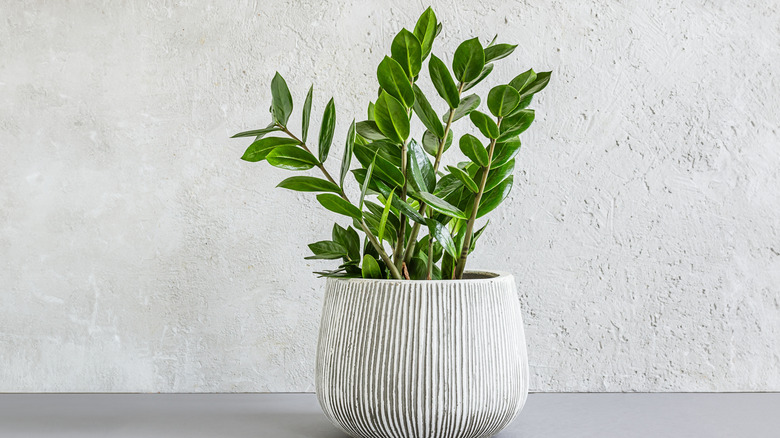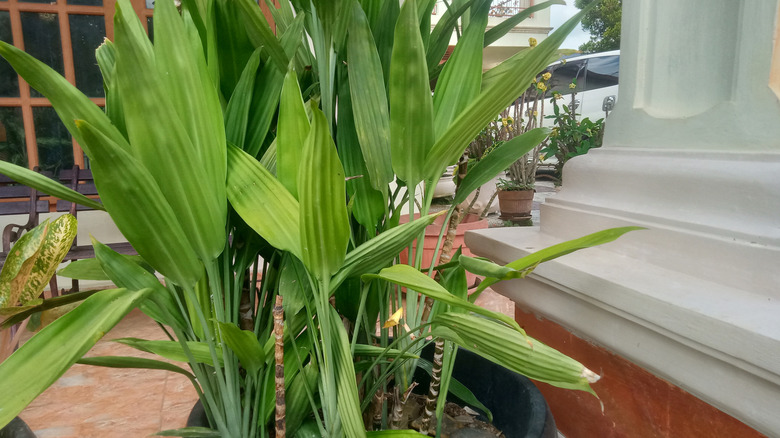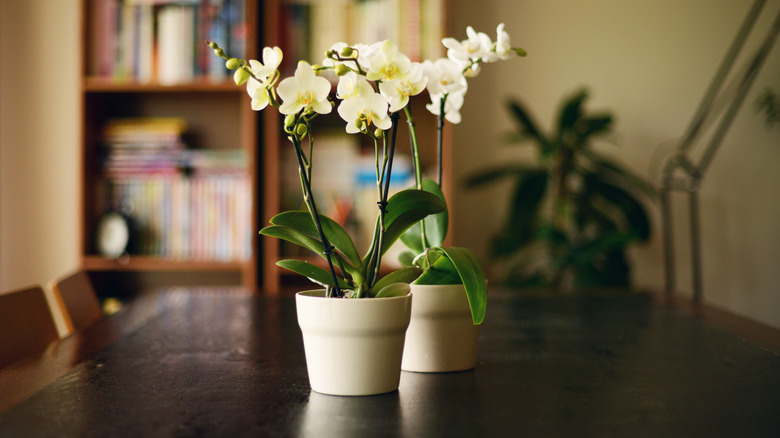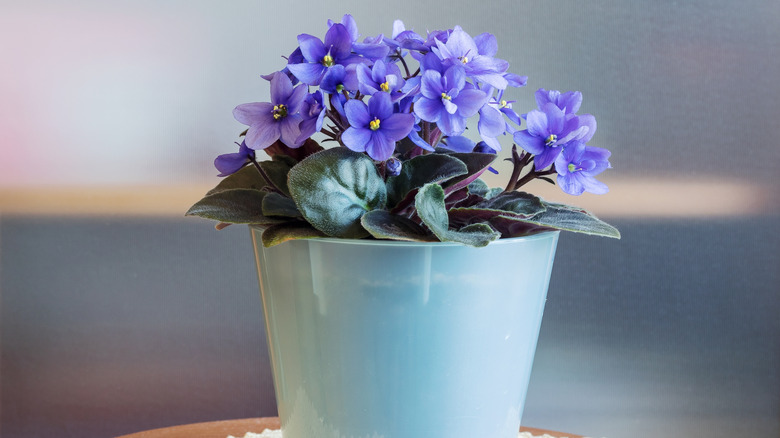Plants You Should Never Keep On A Shelf By A Sunny Window
We may receive a commission on purchases made from links.
Is there anything better than finding that perfect sunny spot for your plants? Whether you're moving into a new place or doing a little decor refresh, getting that sudden "a-ha!" moment when you realize you've found yet another place to put greenery is always a happy feeling. But not every plant wants to sit near that sunny window — and many can't actually hang with that level of intense sunshine.
Windows that let in direct afternoon sun can turn into surprisingly intense microclimates via the greenhouse effect, which can amplify light and heat, and scorch the leaves of some houseplants. So rather than leaving it to chance, here are 13 different plants that would prefer staying away from that new sunny spot on your shelf. We'll go over what's going on when they get hit with too much light and a few recommendations for where to plop those plants instead, so you can ensure your leafy green loves last for years, happy and healthy.
Philodendrons can get their leaves scorched by too much direct sunlight
While philodendrons are often considered to be adaptable houseplants, placing them directly on a sunny windowsill, especially one facing south or west, can quickly lead to a sad-looking plant. The heartleaf philodendron (P. hederaceum) and red-leaf philodendron (P. erubescens) are particularly vulnerable to direct light, so they should be placed in indirect light only. Philodendrons that get direct light will often develop scorched leaves that are brown and crispy or, at the very least, have their bright green foliage begin to look pale and faded, or turn yellow.
There are a few philo types that are somewhat more tolerant of direct light, though. The pink princess philodendron (P. erubescens 'Pink princess') and the split leaf philodendron (P. bipinnatifidum) can do better in high light, but don't push it. Instead, your best bet for a happy philo is somewhere that has medium-to-bright indirect light. The difference between direct and indirect sunlight can get tricky if you're a houseplant novice, so shoot for a west or east-facing window that has a semi-translucent curtain.
Lipstick plant's leaves tend to burn in direct sun
The lipstick plant (Aeschynanthus humilis) may look bright and cheerful, but it's only happy when its lighting conditions are just right. Those eye-catching red flowers can do well in a south-facing window that gets a lot of sun, but only if the light is filtered. Light directly hitting the plant results in burned leaves, which is probably not the look you're going for. But even filtering the light isn't always enough — placement also matters. Lipstick plants need a specific temperature range that stays between 60 degrees and 80 degrees Fahrenheit in the growing season, and 55 degrees to 65 degrees Fahrenheit during dormancy. Unfortunately, many shelves that are right next to windows can have fluctuating temperatures throughout the day, which make it hard for your lipstick plant to be comfortable enough to bloom.
Lipstick plants are native to the forests of southern China, rooting themselves in moss and climbing up tree trunks for survival, rarely receiving direct sun, and instead getting light filtered through the forest canopy. To mimic that habitat, put it somewhere that will give it space to climb or cascade (it's one of the trailing plants that are perfect for hanging baskets) with stable temperatures that keep its soil consistently moist.
Anthurium leaves will wither if their light is too harsh
Anthurium's bold, glossy flowers might make you think they're perfect for a sunny shelf, but the plant has a Goldilocks-style zone for its light needs that can make it very high maintenance. Anthuriums require bright, indirect light and consistently moist soil, so too much direct sunlight will cause scorched leaves, and dry soil, while too little will cause slowed growth and fewer flowers. However, it's better to err on the side of "less is more" and prioritize their need for moisture and humidity over light to prevent apathetic anthurium aesthetics.
There are some anthuriums that can do better in high light and some that thrive in dimmer conditions. The flamingo flower (A. scherzerianum) can tolerate brighter light, as long as it's still indirect, so a shelf that's near a shaded south or west-facing window should be just fine. However, there's another type of anthurium also known as a flamingo flower, A. Andraeanum, that is less tolerant of sun-drenched, drafty windows, or temperature swings, so pay attention to which flamingo flower you're planning to flaunt on that shelf. For the rest of the anthurium family, generally speaking, it's best to stick them somewhere that caters to their love of humidity and stable temperatures, like a plant cabinet or terrarium.
Peace lilies can get stressed if exposed to too much sunlight
Not only are peace lilies (Spathiphyllum) easy houseplants for beginners that almost anyone can keep alive, but they're such a versatile plant that you can hack your indoor peace lily plant care in so many different ways that you'll feel like a straight-up garden scientist. But one thing a peace lily won't tolerate is super bright and sunny conditions. Putting them on a shelf that's too close to a window will result in burned leaves and a pretty rapid decline in health. If the tips of the leaves are starting to brown and get crispy, this is your peace lily saying it's getting too much sun.
Instead, keep your peace lily somewhere that only gets indirect sun, like adjacent to a curtained window. They can even handle deep shade, which is why everyone loves to put them in offices or in that weird, dark corner of a room. However, keep an eye out for signs of too little light: wilted leaves, slow growth, a lack of flowers. But, keep in mind that peace lilies can be total drama llamas that wilt noticeably when they're ready for a drink. Try giving them a good watering to see if they perk up before relocating to a brighter spot.
Chinese evergreens do much better in low light than direct sun
Aglaonemas, commonly known as Chinese evergreens, are gorgeous houseplants, grown for their incredible foliage. However, that awesome foliage only shows its true colors when placed in indirect light, because harsh, direct sunlight will take away their beauty. Aglaonema leaves will start looking pale or dull when placed in too much sun, eventually completely losing their color. If you see the leaf tips start to turn white, your Chinese evergreen is sending out an SOS and needs less intense light ASAP.
Despite looking like a beauty queen, aglaonemas are surprisingly low-maintenance houseplants to care for once you get their growing conditions right. They need medium, diffused light, but can flourish in low light, too, which makes them stand out (as this isn't something you'll commonly find with plants that have such amazing leaf colors). That said, don't stick them in a dark closet or basement; they'll still need a little bit of light — only 10 foot candles worth to survive, if you want to get technical. To give you an idea of just how low you can go, the average interior room typically runs between 20 and 60 foot candles.
Pothos leaves can yellow and develop necrotic spots in direct sun
If you head to any plant nursery you're bound to find a collection of bushy, cascading vine plants. These are likely pothos (Epipremnum aureum), a resilient houseplant that comes in a variety of colors and leaf patterns. Unfortunately, their versatility and resilience ends at direct sunlight, which is a bummer because they look very cool trailing down a shelf on a sunny wall. Scorched spots on the variegated parts of their leaves are a dead giveaway that your pothos is in a setup that has too much direct sunlight and has succumbed to leaf burn and developed necrotic patches.
The true amount of light your pothos will thrive in can vary based on the type. Variegated varieties, while they can tolerate low light setups, tend to need a little more light, and their leaves can revert to green (in an effort to up photosynthesis) when the light levels are too low. If you noticed this happening, move your plants into a more illuminated area that receives bright, indirect light and the variegation should come back. If you want to put your pothos on a shelf to let it climb or trail, make sure it's around 5 feet away from a south or east-facing window that has a sheer curtain to help diffuse the light. East-facing windows can work well, too, since they typically only receive the first few hours of morning sun, but again, try to diffuse the light and keep your pothos a few feet away.
Dracaena's foliage can burn when sitting in sunlight that's too intense
Dracaenas (Dracaena fragrans) go by a few names: corn plant, ribbon plant, dragon tree — but their characteristic wide, striped foliage is a dead giveaway they're all one and the same. That broad leaf design is incredibly efficient at soaking in the light when it needs to photosynthesize, so, consequently, it's not a good fit for sunny spots in your home. If it gets too much light you'll notice the leaves will become brown and crispy, a sign of leaf burn. Also, these guys can get pretty substantial in size, ranging anywhere from 3 to 12 feet tall, making them a hard plant to keep on a shelf, unless you have ridiculously high ceilings.
That said, dracaenas can't handle too little light either; if you notice the leaves begin to shrink and narrow, it's a sign they need a little more light. Shoot for a medium and filtered light setup — around 100 to 150 foot candles. If you're not sure how many foot candles your potential dragon tree room has, there are dozens of free or low-cost phone apps that can measure light. Alternatively, if you use the time spent with your plants as a way to get off your phone — you can also pick up a basic light meter like this SoonKoda Digital Illuminance Light Meter for around $12.
Spider plants can tolerate low light better than they can direct sun
The spider plant (Chlorophytum comosum) is a heartbreaking addition to this list, because they just look so good on shelves, especially when they develop little spiderettes — the baby plants that grow on their tips. While they may be adaptable and resilient, they will not tolerate baking against a wall all afternoon by a super sunny window. If you begin to notice leaf burn, particularly on the leaf tips, then it's a sign your spider plant is getting too much direct light. Though, another reason for this could be fluoride or chlorine in the water. Leaves that looked bleached, where the verdant green stripes have faded to a yellow-ey hue can also indicate too much sun exposure.
So where will your spider plant grow the best? While some types can handle deep shade, it's best to start with medium light, around 100 to 150 foot candles, and go from there. However, if you want plantlets to form, then you'll need to give them fewer than 12 hours of light for around one month. The spiderettes form when the mother plant has lots of time to lounge in the dark, which might seem counterintuitive, but we don't make the rules.
Nerve plants will scorch and shrivel near a drafty or sunny window
The nerve plant (Fittonia albivenis) is grown for its show-stopping leaves. The veining on the leaves is often brightly contrasted, ranging in shades of white, yellow, or red. You might think those bright colors would need lots of light to thrive, but the opposite is true here. Nerve plants need to be kept away from sunny windows for two reasons: drafts and light. If they get too much light, the leaves will begin to look crispy and you'll notice burnt edges due to scorching. Meanwhile, drafty windows will dry the plant out and make its leaves shrivel and drop off, so all in all, it's best to save them for a spot that's closer to the center of the room than the windowed perimeter.
That said, fittonias are really good at going with the flow for other growing conditions. They don't need a lot of humidity or tropical temperatures, and will do just fine in medium or bright, indirect light. Surprisingly, their dwarf variety does okay in terrariums, too, especially if they're on the smaller side, making them awesome plants for home offices. But if you add them to a terrarium, keep an eye on the leaves, because they'll begin to yellow or wither if the plant is getting too much water or humidity.
ZZ plants will scald in the hot afternoon sun coming from a window
The ZZ plant (Zamioculcas zamiifolia) is like the quintessential low-maintenance houseplant. ZZ plants are known for their glossy leaves that are super resilient and grow slowly enough that they can take the occasional "oopsie" from new plant parents. But one thing it absolutely cannot handle is getting too close to a sunny window, because those iconic leaves will begin to scald and turn brown in direct light. Plus, this plant can't tolerate temperatures lower than 60 degrees Fahrenheit, making it difficult for those with cooler winters to keep it healthy when it's sitting near a drafty window.
Other than that, caring for a ZZ plant is ridiculously easy, particularly if you're someone who skews to the neglectful side of the plant parent spectrum. The best way to think about their care needs is "less is more." They store water in their leaves and really don't need much watering; think of them more like a succulent than a tropical plant and treat their water schedules accordingly. They'll also do fine in low light, even if the room's only light source is an overhead fluorescent, which is why you'll often see them in cubicles.
Cast iron plants can tolerate a lot of things, except living near a sunny window
The cast iron plant (Aspidistra elatior) gets its name from its tough-as-nails level of resilience, making it akin to a cast iron pan. But it has one weakness: intense sun is the kryptonite of cast iron plants, and they can suffer severely and look very sad when consistently exposed to harsh, direct sunlight. If placed on a shelf near a sunny window you'll begin to notice scorch marks on its broad leaves and once those burn marks form they're there for good.
To make your cast iron plant happy you'll need to give it a nice, shady spot in your home. We really can't emphasize that enough — cast iron plant's light preferences max out at about the "dappled light" level, think anywhere from 25 to 100 foot candles. The good news is, though, once you get its light needs right the rest is smooth sailing. Cast iron plants aren't picky about their soil, are drought tolerant, and do well both indoors and out for USDA Zones 7 through 11.
Orchids hate direct sun, especially during the summer
Orchids (Phalaenopsis) are crazy; there are over 34,000 registered types and they all have pretty much the same care requirements. Unfortunately, one of those requirements is diffused light; orchids just won't tolerate being in direct sun that's beaming through a window, and those big, beautiful leaves will develop pale scorch marks that can turn into black-rimmed areas of necrosis, and affect photosynthesis. Your orchid needs all of the energy it can get to keep pushing out those iconic flowers, and scorch marks and damaged leaves can affect overall health and flowering.
So, what light level does an orchid actually need? Thankfully, it's not incredibly technical, so breathe a sigh of relief. Instead of foot candles, the American Orchid Society recommends focusing more on the length of time your orchid has access to light, known as a photoperiod, or day length. Phalaenopsis' need at least 6 hours of nearly pitch-black darkness, and maybe more to flower. You'll really need to pay attention to the darkness levels, because plants are extremely good at sensing even the smallest amount of light and a light in an adjacent room can be enough to throw off this resting time. If it's feeling nearly impossible to give your orchid truly dark conditions, put a box or dark cloth over it – this will help shorten the photoperiod.
African violets can't tolerate the wild temperature swings from a window
African violets (Streptocarpus ionanthus) are often sold as plants fit for beginners, but their care requirements can make them a bit of a headache. For example, African violets need bright light to thrive, so you'd think they'd be perfect for hanging out on a shelf near your window. But that light must be filtered; direct sunlight will cause its leaves, known as lobes, to fade in color. More importantly, they're intolerant of fluctuations in temperature and the sun's movement throughout the day will affect the temperature in that microclimate around the window. And if you've got drafty windows, forget about putting an African violet anywhere near, because it'll wilt dejectedly faster than you think.
If there's one area to focus on to ensure the longevity of S. ionanthus, it's maintaining a consistent temperature in its environment, because even the most minor change, like using cold water from the tap, will upset it. Try starting with Bestva's 18 Watt Full Spectrum LED Light, because its stand and timer is perfect for caring for one or a few violets. Plant cabinets are awesome for maintaining temperature consistence, but if you've only got one violet or space is at a premium, use something like NYCP's Glass Cloche Dome with Air Hole and Base and add BN-LINK's Seedling Heat Mat with Thermostat Controller if your indoor space dips below 60 degrees Fahrenheit during the winter.
